Disclosure: We may earn commissions if you purchase products after clicking on a link from our site.
Have you always thought about kudu hunting? Do you want to take home a trophy bull? Do you want to learn how to hunt kudu in Texas? Most hunters have it as a goal to go on a kudu hunt. The Greater Kudu was originally found in south Texas and the Texas hill country; it is one of the most beautiful antelopes. With their big ears, the trophy kudu can detect the faintest of noise from far. Trophy hunters must move with caution to avoid being detected during day hunts.
Moreover, with its 4-12 vertical white stripes and grey or reddish brown coat, it is well camouflaged in its surroundings and is challenging to locate when kudu hunting. In this article, we share information about a Texas kudu hunt.
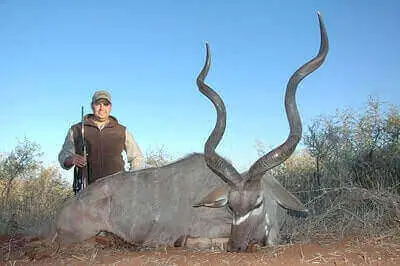
Table of Contents
How To Hunt Kudu In Texas
Hunting kudu in Texas requires careful planning and preparation due to the unique habitat and behavior of these elusive animals. Kudu are native to Africa, but some ranches in Texas offer opportunities to hunt them in semi-wild conditions. Hunters interested in pursuing kudu should first research and select a reputable hunting outfitter or ranch with a good population of kudu. Once a hunting location is chosen, hunters should familiarize themselves with the terrain, vegetation, and typical behavior of kudu in that area.
When hunting kudu in Texas, it’s essential to scout the area beforehand to locate their feeding and watering areas, as well as their preferred travel routes and bedding areas. Kudu are known for their keen senses and are wary of human presence, so hunters must exercise caution and approach stealthily to avoid spooking them. Spot and stalk hunting is a common method used to hunt kudu, where hunters patiently glass the terrain from elevated vantage points and then move in for a closer shot when a suitable kudu is spotted.
Firearms suitable for hunting kudu in Texas typically include high-powered rifles chambered in cartridges like .30-06 Springfield or .300 Winchester Magnum, capable of delivering accurate shots at longer distances. Hunters should ensure they have the appropriate licenses and permits required by the state of Texas and follow all hunting regulations and ethical guidelines.
Additionally, hunters should be prepared for variable weather conditions and rugged terrain when hunting kudu in Texas, as the landscape can be challenging to navigate. Proper camouflage clothing, sturdy footwear, and essential hunting gear such as binoculars, rangefinders, and field dressing equipment are essential for a successful hunt. Finally, hunters should always prioritize safety and respect for the environment while enjoying the exhilarating experience of hunting kudu in the Lone Star State.
History of Kudu
The kudu is a woodland antelope species originally found in the African plains of East and South Africa. It is referred to as the”grey ghost of Africa”. There are 2 species of Kudu antelope: the Lesser Kudu and the Greater Kudu.
They are similar, but the Greater Kudu is taller than the Lesser Kudu. Both have long horns that are curled in a corkscrew shape. The kudu bull weighs about 450-650 pounds while the female kudu weighs about 250-450 pounds.
Hunting Method
For kudu hunts in Texas, spot and stalk, safari style hunting, ground blinds, bow hunting, rifle hunting, and pistol hunting are the hunting methods used to hunt trophy kudu.
Most hunters prefer the spot and stalk hunting method although the safari African style hunting method is also widely used. Other hunters prefer ground blinds overlooking feeders or a food source for kudu hunting.
Spot and Stalk Hunting
Spot and stalk hunting is a popular method for hunting kudu in Texas. This approach involves spotting kudu from a distance, typically from elevated vantage points and then carefully stalking within shooting range to make a clean shot.
Hunters often use binoculars or spotting scopes to locate kudu grazing or moving in open areas. Once a suitable target is identified, hunters must approach cautiously, taking advantage of available cover and terrain features to remain undetected as it is a challenging hunt. This method requires patience, stealth, and skillful marksmanship to ensure a successful exotic hunting trip.
The Texas Parks and Wildlife Department provides regulations and guidelines for hunting kudu in the state, ensuring ethical and sustainable hunting practices. For more information on hunting regulations and licensing requirements in Texas, visit Texas Parks and Wildlife Department.
Still Hunting
Still hunting, also known as stand hunting, involves finding a strategic location near known kudu activity areas and waiting patiently for them to come within shooting range. Hunters typically set up concealed ground blinds or elevated tree stands overlooking well-traveled paths, feeding areas, or water sources frequented by kudu.
This method requires hunters to remain motionless and quiet for extended periods, carefully observing their surroundings for any signs of kudu movement. Still hunting can be particularly effective during the early morning or late evening hours when kudu are most active.
Hunters should adhere to Texas hunting regulations and guidelines to ensure a safe and responsible hunting experience. To learn more about hunting seasons and bag limits for kudu in Texas, consult the Texas Parks and Wildlife Department.
Safari-Style Hunting
Safari-style hunting offers hunters the opportunity to explore expansive hunting properties in search of kudu herds. This method often involves guided hunts conducted on private ranches or game reserves with diverse habitats and abundant wildlife populations.
Hunters typically embark on guided safari-style excursions, either on foot or in vehicles, accompanied by experienced guides who assist in tracking and locating kudu. Once a suitable kudu is spotted, hunters can plan their approach and aim for a safe and ethical distance.
Safari-style hunting allows hunters to immerse themselves in the natural beauty of Texas while pursuing one of Africa’s most iconic big game species. The Texas Parks and Wildlife Department collaborates with private landowners and outfitters to ensure sustainable hunting practices and conservation efforts.
Predator Calls
Calling is a technique used to attract kudu by imitating their vocalizations, such as grunts, barks, or rattling sounds. Hunters can use commercially available kudu calls or rely on their vocal mimicry skills to lure kudu within shooting range.
This method requires careful timing and patience, as kudu may respond cautiously or become wary if they detect any signs of danger. Hunters should study kudu behavior and vocalizations to effectively mimic their calls and increase their chances of success on these exotic hunts. Calling can be an exciting and challenging hunting method that adds an element of strategy and unpredictability to the hunt.
To ensure ethical and responsible hunting practices, hunters should familiarize themselves with Texas hunting regulations and guidelines provided by the Texas Parks and Wildlife Department.
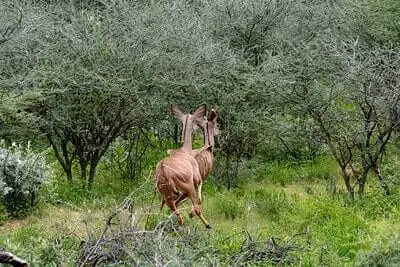
Hunting Season In Texas
In Texas, the hunting season for kudu typically aligns with the broader hunting seasons established by the Texas Parks and Wildlife Department (TPWD). Kudu hunting opportunities may vary depending on the specific regulations and licensing requirements set forth by TPWD and individual landowners or hunting outfitters.
Generally, kudu hunting in Texas is available year-round on private hunting ranches and game reserves that offer guided hunting experiences. However, hunters need to verify the specific hunting season dates, bag limits, and other regulations governing kudu hunting in the state. TPWD periodically updates hunting regulations to ensure sustainable wildlife management practices and conservation efforts.
Hunters should consult TPWD’s official website or contact local wildlife authorities for the latest information on kudu hunting seasons and regulations in Texas. Additionally, ethical and responsible hunting practices, such as fair chase principles and compliance with licensing requirements, are crucial to maintaining healthy kudu populations and preserving Texas’s hunting heritage.
Kudu Meat
Kudu meat is highly prized for its exceptional taste and quality, often considered a delicacy among hunters and connoisseurs alike. Known for its lean and tender texture, kudu meat offers a unique flavor profile characterized by its subtle sweetness and mild gamey undertones.
This venison is rich in protein and low in fat, making it a healthy alternative to traditional red meats. The meat’s natural leanness lends itself well to various cooking methods, including grilling, roasting, and pan-searing. Kudu steaks are particularly popular and are often seasoned simply to allow the meat’s natural flavors to shine.
Additionally, kudu meat can be used in a variety of culinary creations, from hearty stews and chili to gourmet burgers and kebabs. Beyond its culinary appeal, kudu meat is also valued for its cultural significance in regions where the kudu is indigenous, often being a staple food source for local communities. Overall, kudu meat offers a flavorful and nutritious dining experience that reflects the wild beauty of the African savanna where these majestic animals roam.
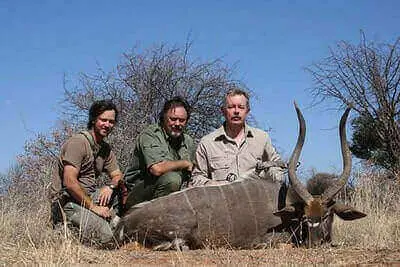
Hiring An Outfitter
Hiring an outfitter for kudu hunting in Texas can greatly enhance the overall hunting experience, especially for those unfamiliar with the terrain and local regulations. A reputable outfitter offers valuable expertise and logistical support, ensuring hunters have the best chance of success while adhering to all legal requirements and ethical hunting practices.
Great guides provide well-equipped hunting facilities, including comfortable lodging, transportation, and access to prime hunting areas where kudu are known to roam. Experienced guides accompany hunters throughout the excursion, offering invaluable knowledge of the terrain, kudu behavior, and optimal hunting tactics.
Additionally, outfitters may assist with obtaining necessary permits and licenses, saving hunters time and hassle. By enlisting the services of a professional guide, hunters can focus on the hunt of native wildlife while enjoying a safe and well-organized expedition in North America.
It’s essential to research and select a reputable outfitter with the experience level and a proven track record of providing quality hunting experiences and prioritizing wildlife conservation. Consulting reviews, testimonials, and recommendations can help ensure a memorable and successful kudu hunting adventure in the Lone Star State.
Best Time To Hunt Greater Kudu
Kudu is most active in the morning and afternoon. Therefore, kudu hunting is best early in the morning, during the afternoon, or sitting in blinds on a Texas kudu hunt for trophy kudu bulls.
Trophy kudu are difficult to locate as they spend most of their time in heavy brushy cover and are camouflaged to their surroundings with their grey or reddish-brown coat and white stripes.
Additionally, the best time to hunt kudu in Texas typically coincides with the cooler months of the year, particularly from late fall to early spring. During this time, kudu are more active and readily seek food and water sources, making them more predictable and easier to locate.
Furthermore, the cooler temperatures make hunting more comfortable for both hunters and the animals themselves, as kudu are less likely to be active during the scorching heat of summer. Moreover, this period often aligns with the breeding season of kudu, known as the rut, when mature males are more aggressive and vocal, making them easier to locate and target.
Hunters must consider the specific climate and weather patterns of the region they plan to hunt in, as well as any local hunting regulations and seasons. Consulting with experienced guides or outfitters familiar with the area can provide valuable insights into the optimal timing for a successful kudu hunting expedition in Texas.
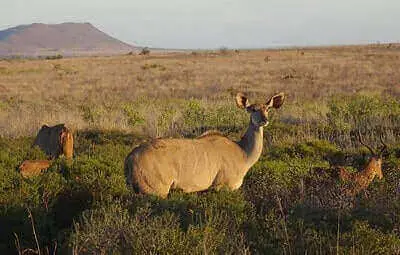
Kudu Diet
Greater kudu eats leaves, flowers, fruits, tubers, and shoots from trees, bushes, grasses, herbs, and vines. They are herbivores. The teeth arrangement is designed for pulling and grinding of these leaves, flowers, and shoots.
In Texas, kudu, a species native to Africa, adapt their diet to the available vegetation and forage in their new habitat. The diet of kudu in Texas primarily consists of a variety of grasses, browse, leaves, and fruits found in the local landscape. They are known as browsers, meaning they primarily feed on leaves, twigs, and shoots of trees and shrubs rather than grasses.
Some of the preferred food sources for kudu in Texas include mesquite, huisache, and acacia trees, as well as various types of shrubs and bushes. Additionally, they may consume crops if available, posing challenges for farmers.
Kudu are selective feeders, often choosing young, tender foliage and avoiding tougher, mature plants. Their ability to adapt to different food sources allows them to thrive in a range of habitats, from dense woodlands to savannas and brushy areas. Understanding the dietary preferences of kudu is essential for hunters and wildlife managers in Texas to effectively manage populations and conserve their natural habitat.
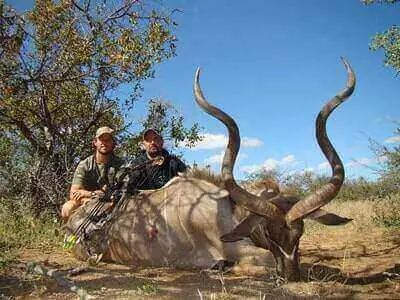
The Bottom Line
Kudu is the second largest antelope in the world and is a rare species. It is found in Eastern and Southern Africa. Kudu hunts are exciting and challenging to hunt as it is well camouflaged and difficult to locate with their grey or reddish brown coat with white stripes. With a growing population of greater kudu, Texas is the place where novice hunters and experienced ones go for great hunts of kudu. It is one of the most sought-after trophies. Like axis deer, fallow deer, and scimitar oryx, kudu is an exotic animal sought after by an avid hunter.
In this article, we discussed kudu hunting to help you improve the odds of taking a trophy kudu bull home and fulfilling your hunting dream.
If you are interested in hunting other exotic animals, you can also read how to hunt nilgai antelope, how to hunt aoudad, how to hunt oryx in New Mexico, and how to hunt dall sheep.